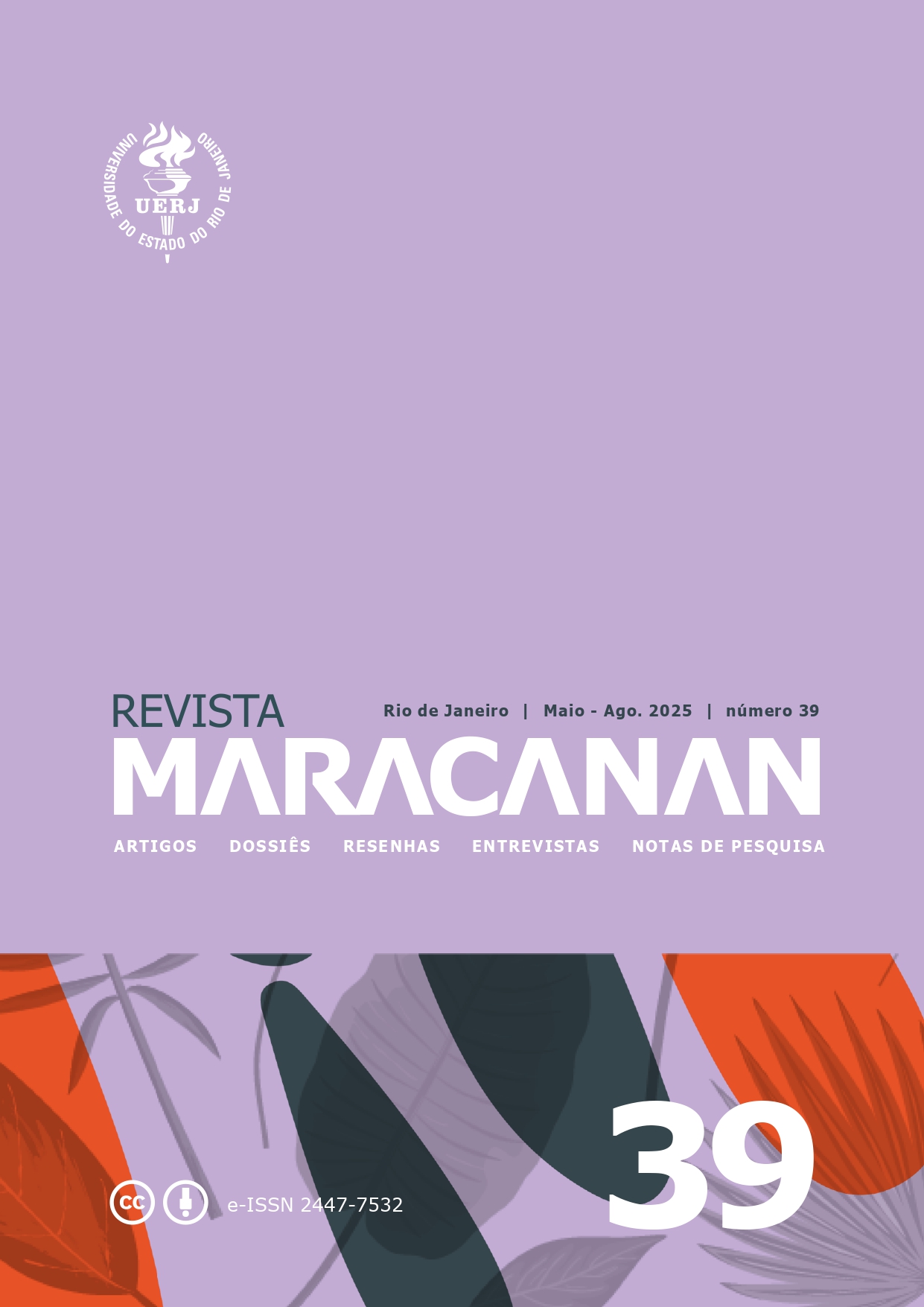Tricontinentalismo para crianças:
N'vula (1981) e a construção ficcional do “homem novo” em Cuba e Angola
DOI:
https://doi.org/10.12957/revmar.2025.82740Palabras clave:
Tricontinentalismo, Homem Novo, Cinema de Animação, Cuba, AngolaResumen
El artículo presenta un análisis de la animación cubana N’vula (1981), escrita por el director Juan Padrón. Este autor, más conocido por la película Vampiros en La Habana (1985) y la serie de animación Elpidio Valdés, estrenó N'vula, un corto de 9 minutos, en el contexto de la Operación Carlota, una acción militar organizada por el gobierno cubano con el objetivo de para apoyar el régimen de gobierno recientemente instalado del Movimiento Popular para a Libertação de Angola (MPLA). La ejecución de esta operación puede entenderse através de la idea del tricontinentalismo, aquí considerado una doctrina de política exterior cubana, basada en el tercermundismo y el internacionalismo socialista. Con Che Guevara como uno de sus representantes más icónicos, el tricontinentalismo estuvo estrechamente relacionado con la idea del Hombre Nuevo, promovida por varios estados marxista-leninistas, y también teorizada por el revolucionario latinoamericano. Este contexto resulta fundamental para la discusión de los significados de N'vula, que, al dirigirse a los niños, se revela como un instrumento de propagación del tricontinentalismo infantil en una época en la que el ICAIC (Instituto Cubano del Arte e Industria Cinematográficas) impulsó una serie de obras sobre la realidad angolana y las acciones cubanas en ese país. Los protagonistas de N’vula son niños “pioneros”, educados dentro de los parámetros marxistas del MPLA en zonas liberadas, que se enfrentan a crueles soldados portugueses patrocinados por el imperialismo, cuyo objetivo era destruir su escuela y su aldea. La película presenta una proyección de cómo debería ser el Hombre Nuevo socialista, ya creado dentro de una lógica educativa que pretendía ser “revolucionaria” y libre de los supuestos de la burguesía. Por ello, podemos considerar que la obra encarna los preceptos del tricontinentalismo, sirviendo como una suerte de proyección idealizada de cómo debería ser el futuro de las naciones marxistas.
Citas
ALMER, Marisabel. Remembering Angola – Cuban internationalism, transnational spaces, and the politics of memories. 2011. Tese (PhD in Anthropology) – University of Michigan, Ann Arbor, 2011.
AOKI, Aemi. Os meninos-pioneiros nas obras de Pepetela, Manuel Rui e Ondjaki. Revista Acadêmica Todas As Musas, São Paulo, ano 8, n. 2, p. 41-47, jan.-jul. 2017.
ARRUDA. Claudia Maria C. Manual Cívico de Combate e Disciplina: o ensino em Angola sob a égide do MPLA. Com a Palavra, o Professor, Vitória da Conquista (BA), v. 5, n. 11, p. 195-211, 2020.
CAULINEAU, Aramís Acosta. Historias animadas de ayer y hoy. Cine latino-americano, 2008. Disponível em: http://cinelatinoamericano.org/biblioteca/fichaanalitica.aspx?cod=668. Acesso em :11 mar. 2024.
GUEVARA, Ernesto Che. El Hombre Nuevo. Cidade do México: Coordinación de Humanidades, Centro de Estudios Latinoamericanos, UNAM, 1978.
DE LA CRUZ, Caridad Blanco. El Departamento de Dibujos Animados del ICAIC y la animación experimental de la década del sessenta. Cubarte: Portal de la cultura cubana, 2 out. 2021. Disponível em: https://cubarte.cult.cu/blog-cubarte/el-departamento-de-dibujos-animados-del-icaic-y-la-animacion-experimental-en-la-decada-del-sesenta/. Acesso em: 11 mar. 2024.
DORFMAN, Ariel; MATTELART, Armand. Para ler o Pato Donald. Comunicação de Massa e Colonialismo. São Paulo: Paz e Terra, 1980.
GLEIJESES, Piero. Moscow’s Proxy? Cuba and Africa 1975-1988. Journal of Cold War Studies, Cambridge, v. 8, n. 4, p. 98-146, Fall 2006.
HATZKY, Cristine. “Os Bons Colonizadores”: Cuba’s Educational Mission in Angola, 1976-1991. Safundi: The Journal of South African and American Studies, Routledge, v. 9, n. 1, p. 53-68, jan. 2008.
KAMINSKI, Rosane. Reflexões sobre a pesquisa histórica, a ficção e as artes. In: FREITAS, A.; KAMINSKI, R. (Org.). História e arte: encontros disciplinares. São Paulo: Intermeios, 2013.
MIRABAL, Nancy Raquel; LAÓ-MONTES, Agustin. Technofuturos: Critical Interventions in Latina/O Studies. Plymouth: Lexington Books, 2007.
MORENO. Juan Pablo P. Mickey Mouse y Elpidio Valdés: dos modelos sociales y políticos representados em cine de animación. Creación y Producción em Diseño y Comunicación [Trabajos de estudiantes y egresados]. Universidad de Palermo – Facultad de Diseño y Comunicación, Buenos Aires, n. 24, 2009.
OLIVEIRA, Fábio Nogueira de. Intelectuais da Raça de Cor, Nacionalismo e Afro-Cubanismo (1912-1945). 2015. Tese (Doutorado em Sociologia) – Faculdade de Filosofia, Letras e Ciências Humanas, Universidade de São Paulo, São Paulo, 2015.
RANCIÈRE, Jacques. A historicidade do cinema. Significação, Universidade de São Paulo, São Paulo, v. 44, n. 48, p. 245-263, jul.-dez. 2017.
ROSENSTONE, Robert. La Historia en el Cine – El cine sobre la Historia. Madrid: RIALP, 2014.
SILVA, Alexandro de Sousa. A câmera e o canhão: circulação das imagens cinematográficas entre Cuba e países africanos (1960-1991). 2020. Tese (Doutorado em História Social) – Universidade de São Paulo, São Paulo, 2020.
SILVA, Renata Flávia da. Amílcar Cabral e Pepetela: processos intertextuais a propósito do Homem Novo. Lusotopie – Recherches politiques internationales sur les espaces issus de l’historie et de la colonisation portugaises, v. XIX, n. 1, 2020.
VANYONE, Francis; GOLIOT-LÉTE, Anne. Ensaio sobre a análise fílmica. São Paulo: Papirus, 2002.
VILLAÇA, Mariana Martins. O Instituto Cubano del Arte e Industria Cinematográficos (ICAIC) e a política cultural em Cuba. 2006. Tese (Doutorado em História Social) – Universidade de São Paulo, São Paulo, 2006.
Descargas
Publicado
Cómo citar
Número
Sección
Licencia
Derechos de autor 2025 Ivan Araújo Lima

Esta obra está bajo una licencia internacional Creative Commons Atribución 4.0.
Os autores mantêm os direitos autorais e concedem à Revista Maracanan o direito de publicação, sob uma Licença Creative Commons Atribuição 4.0 Internacional, a qual permite que outros distribuam, remixem, adaptem e criem a partir do seu trabalho, mesmo para fins comerciais, desde que lhe atribuam o devido crédito pela criação original.
Os dados e conceitos abordados são da exclusiva responsabilidade do autor.
A Revista Maracanan está licenciada com uma Licença Creative Commons Atribuição 4.0 Internacional.





